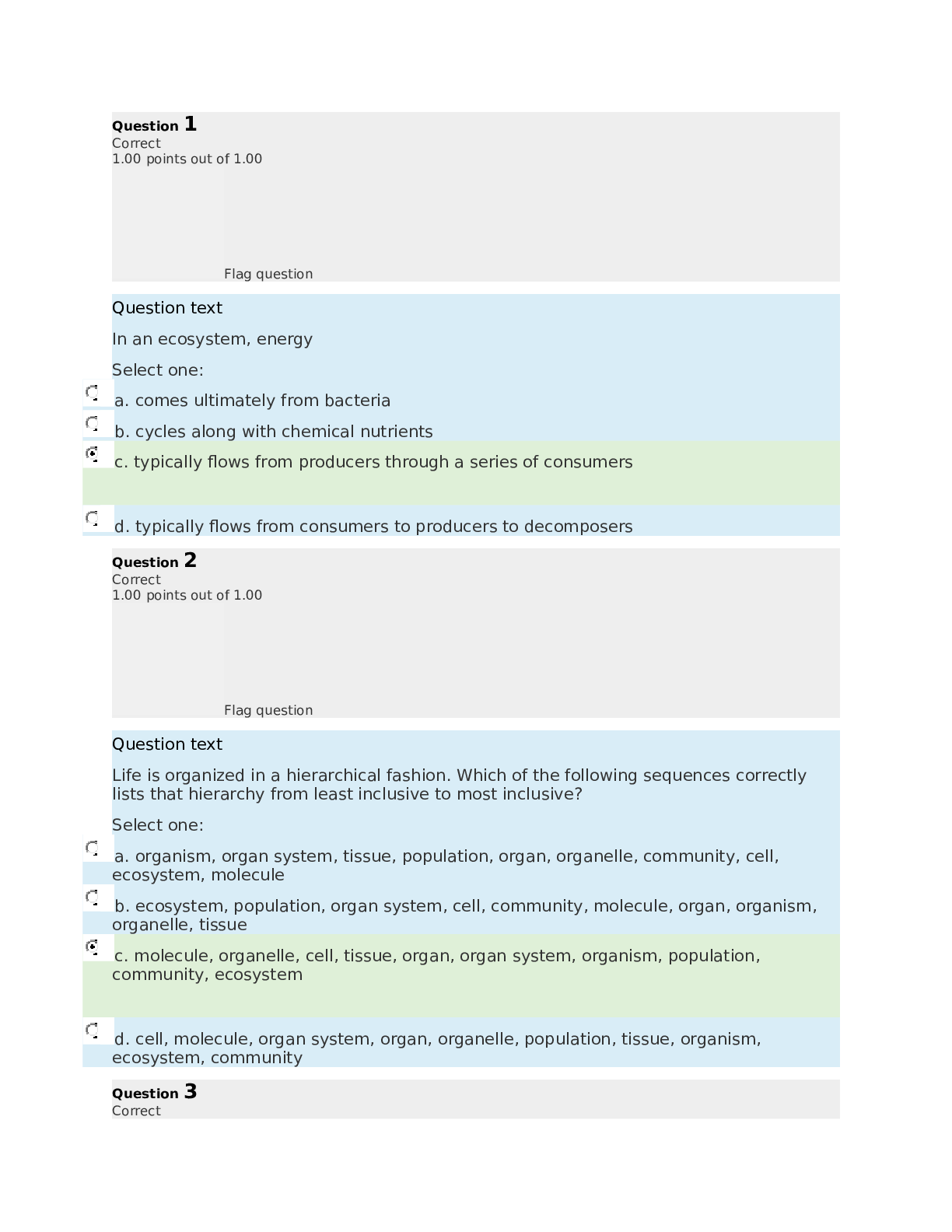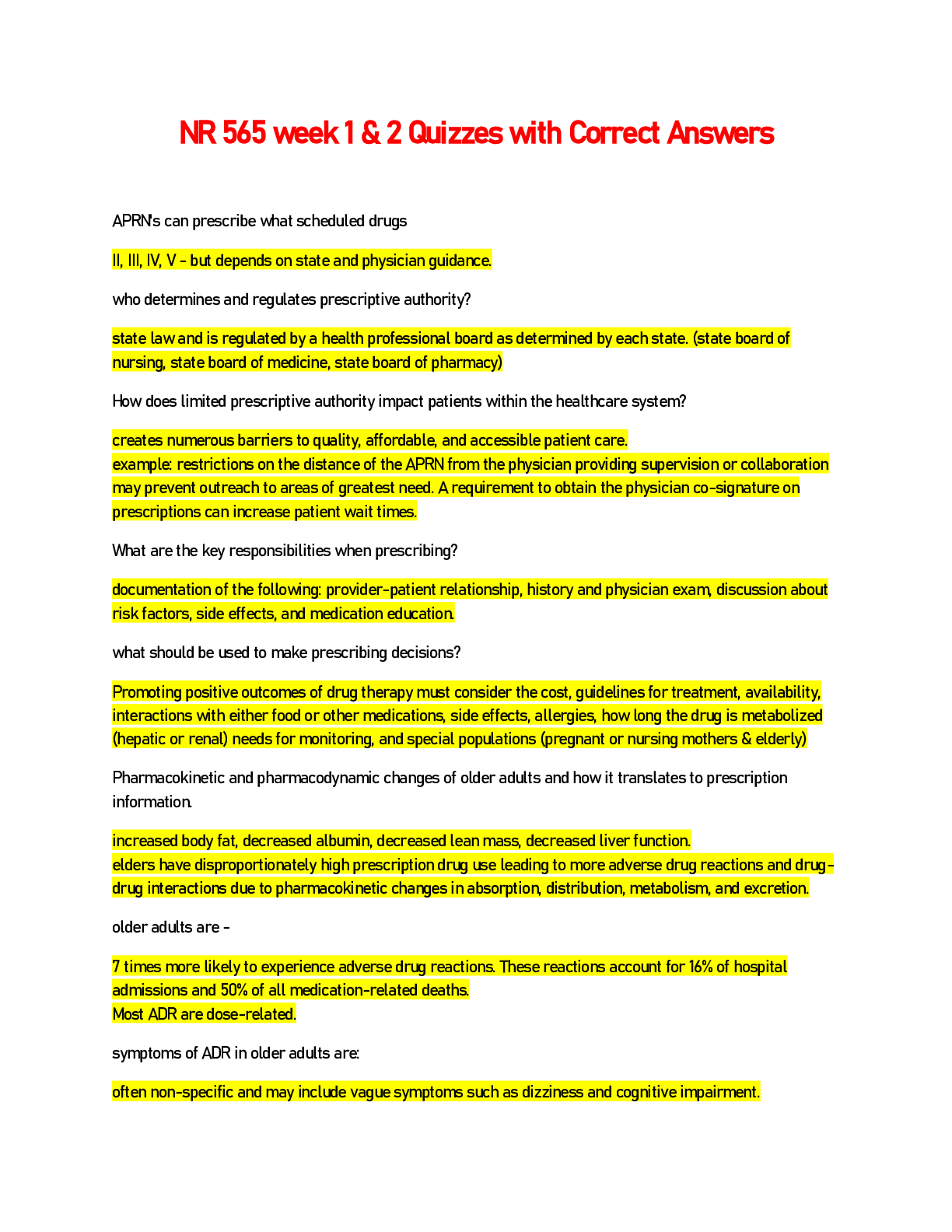Biology > EXAM > STRAIGHTERLINE BIO 201 ANATOMY AND PHYSIOLOGY I- COMPLETE FULL COURSE SEPTEMBER 2021 ( ALL QUIZZES W (All)
STRAIGHTERLINE BIO 201 ANATOMY AND PHYSIOLOGY I- COMPLETE FULL COURSE SEPTEMBER 2021 ( ALL QUIZZES WITH CORRECT ANSWERS SHOWN)
Document Content and Description Below
Course Content General Introduction and Getting Started Topic 1: Introduction to Anatomy and Physiology Topic 2: Chemistry for Anatomy and Physiology Students Topic 3: Cell Bi... ology Topic 4: Genetics Topic 5: Tissues Topic 6: Integumentary System Topic 7: Bones and Skeletal System Topic 8: Joints Topic 9: Muscular System Histology and Physiology Topic 10: Muscular System Gross Anatomy Topic 11: Functional Organization of Nervous Tissue Topic 12: Spinal Cord, Spindal Nerves, Brain and Cranial Nerves Topic 13: Integration of Nervous System Functions Topic 14: The Special Senses Topic 15: Autonomic Nervous System Topic 16: Functional Organization of the Endocrine System Question 1 Correct 1.75 points out of 1.75 Flag question Question text Anatomy is Select one: a. the study of function. b. a branch of physiology. c. the study of structure. d. the study of living organisms. e. the study of homeostasis. Question 2 Correct 1.75 points out of 1.75 Flag question Question text A tissue is a Select one: a. structure contained within a cell. b. lower level of organization than a cell. c. group of organs that performs specific functions. d. group of cells with similar structure and function. e. structure that contains a group of organs. Question 3 Correct 1.75 points out of 1.75Flag question Question text Magnetic resonance imaging is based on the movement of Select one: a. electrons in a magnetic field. b. carbons in a magnetic field. c. protons in a magnetic field. d. cells in a magnetic field. Question 4 Correct 1.75 points out of 1.75 Flag question Question text Which subdivision of anatomy involves the study of organs that function together? Select one: a. regional b. developmental c. systemic d. histology e. surface anatomy Question 5 Correct 1.75 points out of 1.75 Flag question Question textThe study of the body's organization by areas is Select one: a. systemic anatomy. b. regional anatomy. c. molecular biology. d. microbiology. e. surface anatomy. Question 6 Correct 1.75 points out of 1.75 Flag question Question text The delivery of a radioactive compound to the body to study the metabolism of tissues is called Select one: a. MRI. b. PET. c. DSA. d. DSR. Question 7 Correct 1.75 points out of 1.75 Flag question Question text An organelle is Select one: a. a small structure within a cell. b. a structure composed of several tissue types.c. the basic structural unit of all living organisms. d. a group of organs with a common set of functions. e. a group of cells with similar structure and function. Question 8 Correct 1.75 points out of 1.75 Flag question Question text A cell is Select one: a. a small structure within a molecule. b. a structure composed of several tissue types. c. the basic structural unit of living organisms. d. a group of organs with a common set of functions. e. a group of atoms with similar structure and function. Question 9 Correct 1.75 points out of 1.75 Flag question Question text An organ is Select one: a. a small structure within a cell. b. a structure composed of several tissue types. c. the basic structural unit of all living organisms. d. a group of molecules with a common set of functions. e. a group of cells with similar structure and function. Question 10 Correct1.75 points out of 1.75 Flag question Question text A major limitation of radiographs is that they Select one: a. can only visualize bone. b. give only a flat, two-dimensional image of the body. c. are old technology that do not give good results. d. have very few applications. Question 11 Correct 1.75 points out of 1.75 Flag question Question text The thumb is ___ to the fifth digit (little finger). Select one: a. distal b. lateral c. medial d. proximal e. superficial Question 12 Correct 1.75 points out of 1.75 Flag questionQuestion text Which of the following describes the position of the nose? Select one: a. inferior to the chin b. superior to the forehead c. posterior to the ears d. lateral to the eyes e. superior to the mouth Question 13 Correct 1.75 points out of 1.75 Flag question Question text The antebrachial region is the Select one: a. area in front of the elbow. b. chest area. c. lower back. d. bottom of foot. e. forearm. Question 14 Incorrect 0.00 points out of 1.75 Flag question Question textThis is a sagittal section through the abdominopelvic cavity. What serous membrane does "C" represent? Select one: a. visceral peritoneum (covers organs) CORRECT b. mesentery c. parietal peritoneum (lines cavity) d. retroperitoneal organs Correct 1.75 points out of 1.75 Flag questionQuestion text While Stacy is in the process of passing over the bar during a pole vault, her hips are considered to be Select one: a. anterior to her shoulders. b. posterior to her shoulders. c. inferior to her shoulders. d. superior to her shoulders. e. cephalic to her shoulders. Question 16 Correct 1.75 points out of 1.75 Flag question Question text Which of the following is most consistent with homeostasis? Select one: a. As blood pressure falls, blood flow to cardiac (heart) muscle decreases. b. As the mean blood pressure gradually increases in aging people, the blood vessel walls become thinner. c. Men working in a hot environment drink large quantities of water, and their urine volume increases. d. As body temperature decreases, blood vessels in the periphery dilate. e. Elevated blood glucose levels cause insulin secretion (insulin causes cells to take up glucose) to increase. Question 17 Correct 1.75 points out of 1.75 Flag question Question textThe integumentary system Select one: a. regulates body temperature. b. breaks down food into small particles for absorption. c. controls intellectual functions. d. produces body movements. e. coordinates and integrates body function. Question 18 Correct 1.75 points out of 1.75 Flag question Question text The cervical region is the Select one: a. calf. b. armpit. c. hollow behind the knee. d. neck. e. thigh. Question 19 Correct 1.75 points out of 1.75 Flag question Question text The lumbar region is the Select one: a. area in front of the elbow. b. chest area.c. lower back. d. bottom of foot. e. forearm. Question 20 Correct 1.75 points out of 1.75 Flag question Question text The shoulder is _____ to the elbow. Select one: a. lateral b. dorsal c. distal d. ventral e. proximal BIO201_MH_V3 Topic 2: Chemistry for Anatomy and Physiology Students Started on Tuesday, September 7, 2021, 4:35 AM State Finished Completed on Tuesday, September 7, 2021, 5:05 AM Time taken 29 mins 47 secs Grade 35.00 out of 35.00 (100%) Question 1 Correct 1.75 points out of 1.75 Flag question Question text Intermolecular forces are weak electrostatic attractions that exist between Select one: a. two molecules b. a proton and an electron c. two protons Question 2 Correct 1.75 points out of 1.75 Flag questionQuestion text A cation is Select one: a. a combination of atoms held together by chemical bonds. b. a positively charged ion. c. a negatively charged ion. d. a molecule that conducts electricity when placed in solution. e. an alteration in the three-dimensional structure of a protein. Question 3 Correct 1.75 points out of 1.75 Flag question Question text Subatomic particles located around the nucleus of an atom are Select one: a. protons. b. electrons. c. neutrons. d. neutrinos. e. photons. Question 4 Correct 1.75 points out of 1.75 Flag question Question text The number of atoms in exactly 12 grams of carbon-12 is called Select one:a. Dalton's number. b. Socrates's number. c. Avogadro's number. d. Pasteur's number. e. Le Chatelier's number. Question 5 Correct 1.75 points out of 1.75 Flag question Question text In the reversible reaction, CO2 + H2O ↔ H2CO3 ↔ H+ + HCO3- , a decrease in respiration rate will increase the concentration of CO2 in the blood. What will this do to the amount of H+ in the blood? Select one: a. H+ will increase. b. H+ will decrease. c. H+ will be unchanged. Question 6 Correct 1.75 points out of 1.75 Flag question Question text An atom of chlorine has 17 protons and 18 neutrons. Which of the following statements is true? Select one: a. Chlorine atoms have 18 electrons. b. Chlorine has a mass number of 35.c. Chlorine has an atomic number of 18. d. Chlorine has 35 electrons. e. Chlorine has an atomic number of 35. Question 7 Correct 1.75 points out of 1.75 Flag question Question text Which of the following factors will influence the rate of chemical reactions? Select one: a. temperature b. concentration of reactants c. presence of catalysts d. presence of enzymes e. All of these factors will influence the rate of chemical reactions. Question 8 Correct 1.75 points out of 1.75 Flag question Question text In a reversible reaction, when the rate of product formation is equal to the rate of reactant formation, the reaction is Select one: a. stopped. b. at equilibrium. c. in danger of exploding. d. a net decomposition reaction.e. a net synthesis reaction. Question 9 Correct 1.75 points out of 1.75 Flag question Question text A substance composed of two or more different types of atoms is a(n) Select one: a. compound. b. element. c. ion. d. molecule. e. compound and a molecule. Question 10 Correct 1.75 points out of 1.75 Flag question Question text The presence of water in our bodies allows us to Select one: a. cool the body with sweat. b. maintain a fairly constant body temperature. c. provide an environment for chemical reactions. d. keep tissues moist and reduce friction. e. All of these choices are correct. Question 11 Correct1.75 points out of 1.75 Flag question Question text Starch is the Select one: a. storage carbohydrate in animals. b. storage carbohydrate in plants. c. nondigestible plant polysaccharide. d. major nutrient for most body cells. e. sugar found in RNA. Question 12 Correct 1.75 points out of 1.75 Flag question Question text Eicosanoids Select one: a. are structural proteins. b. are fat-soluble vitamins. c. are components of the plasma membrane. d. comprise the genetic material. e. play a role in the response of tissues to injuries. Question 13 Correct 1.75 points out of 1.75Flag question Question text Cellulose is the Select one: a. storage carbohydrate in animals. b. storage carbohydrate in plants. c. nondigestible plant polysaccharide. d. major nutrient for most body cells. e. sugar found in RNA. Question 14 Correct 1.75 points out of 1.75 Flag question Question text Which of the following lists includes only monosaccharides that are isomers of one another? Select one: a. glycogen, glucose, sucrose b. starch, glycogen, cellulose c. glucose, fructose, galactose d. ribose, glycogen, glucose e. deoxyribose, glycogen, starch Question 15 Correct 1.75 points out of 1.75Flag question Question text Water accounts for 50% of the weight of a young adult female and 60% of a young adult male. What kind of atom is found at "C"? Select one: a. hydrogen bond b. water molecule c. oxygen atomd. hydrogen atom e. polar covalent bond Question 16 Correct 1.75 points out of 1.75 Flag question Question text Which of the following organic groups does an enzyme belong to? Select one: a. carbohydrate b. protein c. lipid d. nucleic acid e. vitamin Question 17 Correct 1.75 points out of 1.75 Flag question Question text The mass of a chemical equal to its molecular weight in grams, containing 6.023 x 1023 molecules is a(n) Select one: a. mole b. molarity c. ion d. atomic mass unitQuestion 18 Correct 1.75 points out of 1.75 Flag question Question text Polysaccharides Select one: a. are formed when sucrose and glucose combine. b. are the smallest carbohydrates. c. contain carbon, hydrogen, and phosphate atoms. d. contain long chains of monosaccharides. e. are not found in plants. Question 19 Correct 1.75 points out of 1.75 Flag question Question text The pH value Select one: a. increases with acidity. b. is measured on a scale from 0 to 10. c. is determined by the concentration of hydrogen ions. d. reflects the sodium content of body fluids. e. decreases with alkalinity. Question 20 Correct 1.75 points out of 1.75Flag question Question text Phospholipids are important components of the plasma membrane. What does "E" represent on the diagram? Select one: a. phosphorus b. oxygen c. nitrogen d. polar (hydrophilic) region e. nonpolar (hydrophobic) region Page path BIO201_MH_V3 Topic 3: Cell Biology Started on Tuesday, September 7, 2021, 5:20 AM State Finished Completed on Tuesday, September 7, 2021, 5:44 AM Time taken 23 mins 57 secs Grade 35.00 out of 35.00 (100%) Question 1 Correct 1.75 points out of 1.75 Flag question Question text The lower limit of resolution of a light microscope is Select one: a. 100μm b. 0.1μm c. 10μm d. 0.01μm e. 1.0μm Question 2 Correct 1.75 points out of 1.75Flag question Question text What structure does "C" represent on the diagram of the plasma membrane? Select one: a. membrane channel protein b. phospholipid bilayer c. internal membrane surface d. peripheral protein e. integral protein Question 3 Correct 1.75 points out of 1.75 Flag question Question textWhat structure does "B" represent on the diagram of the plasma membrane? Select one: a. membrane channel protein b. phospholipid bilayer c. internal membrane surface d. peripheral protein e. integral protein Question 4 Correct 1.75 points out of 1.75 Flag question Question textWhat structure does "E" represent on the diagram of the plasma membrane? Select one: a. membrane channel protein b. phospholipid bilayer c. internal membrane surface d. peripheral protein e. receptor protein Question 5 Correct 1.75 points out of 1.75 Flag question Question textWhat structure does "A" represent on the diagram of the plasma membrane? Select one: a. membrane channel protein b. phospholipid bilayer c. internal membrane surface d. peripheral protein e. integral protein Question 6 Correct 1.75 points out of 1.75 Flag question Question text Which of the following is NOT true of a transmission electron microscope (TEM)? Select one: a. The limit of resolution is about 0.1nm. b. Electrons are passed through the specimen. c. Gives the clearest three-dimensional images.d. The specimen must be fixed in plastic. e. The electron beam is focused with electromagnets. Question 7 Correct 1.75 points out of 1.75 Flag question Question text Which of the following is NOT a characteristic function of a cell? Select one: a. reproduction and inheritance b. metabolism and energy use c. movement d. synthesis e. communication Question 8 Correct 1.75 points out of 1.75 Flag question Question textThe cell is the basic unit of life. All cellular structures exhibit special functions. Match the structure with its function. What is the function of "B"?Select one: a. directs cellular activities, contains DNA b. contains digestive enzymes c. outer boundary of cell, controls entry and exit of substances d. major site of ATP synthesis when oxygen is available e. site of protein synthesis Question 9 Correct 1.75 points out of 1.75 Flag question Question text Which of the following would increase the maximum rate of facilitated diffusion? Select one:a. increase the concentration gradient of the transported molecule to the saturation point b. decrease the concentration gradient of the transported molecule c. increase the concentration of the competitive molecules d. increased ATP synthesis e. None of these choices is correct. Question 10 Correct 1.75 points out of 1.75 Flag question Question text In ______________, carrier molecules move a substance against (up) the concentration gradient. Select one: a. simple diffusion b. exocytosis c. facilitated diffusion d. active transport e. endocytosis Question 11 Correct 1.75 points out of 1.75 Flag question Question text In general, water-soluble molecules diffuse through the ______ ______; and lipid-soluble molecules diffuse through the ______ ______. Select one:a. membrane channels; membrane channels b. membrane channels; lipid bilayer c. lipid bilayer; membrane channels d. lipid bilayer; lipid bilayer e. None of these choices is correct. Question 12 Correct 1.75 points out of 1.75 Flag question Question text Cells of the small intestine and kidney tubules have extensions that increase their surface area called Select one: a. cilia. b. hairs. c. ruguae. d. microvilli. e. flagella. Question 13 Correct 1.75 points out of 1.75 Flag question Question textRed blood cells (RBCs) have been placed in three different solutions: hypotonic, hypertonic, isotonic. What is solution "C" relative to the RBC? Select one: a. hypotonic solution b. hypertonic solution c. isotonic solution d. hemolyzed e. crenated Question 14 Correct 1.75 points out of 1.75 Flag question Question text The structural RNA of ribosomes is a Select one: a. pre-mRNA. b. proenzyme. c. gene. d. ribosomal RNA (rRNA). e. codon.Question 15 Correct 1.75 points out of 1.75 Flag question Question text Answer these questions about chromosome structure. What does "C" represent? Select one: a. chromatid b. proteins c. chromosome d. centromeree. chromatin Question 16 Correct 1.75 points out of 1.75 Flag question Question text DNA replication occurs during Select one: a. the G1 phase of interphase. b. telophase. c. the S phase of interphase. d. anaphase. e. metaphase. Question 17 Correct 1.75 points out of 1.75 Flag question Question text In DNA replication, Select one: a. the leading strand is formed as a continuous strand. b. new nucleotides are added at the 5' end of the growing DNA strand. c. DNA polymerase splices the short segments of the lagging strand together. d. only introns are replicated. e. the two existing strands are not used as templates. Question 18 Correct1.75 points out of 1.75 Flag question Question text In which part of the cell cycle do chromosomes align along the equator? Select one: a. interphase b. prophase c. metaphase d. anaphase e. telophase Question 19 Correct 1.75 points out of 1.75 Flag question Question text Messenger RNA Select one: a. is synthesized when a portion of a DNA molecule is transcribed. b. directs the synthesis of DNA. c. determines the sequence of nucleotides in the anticodons of tRNA. d. directs the synthesis of centrioles in the cytoplasm. e. is not involved in the synthesis of proteins. Question 20 Correct 1.75 points out of 1.75Flag question Question text Which of the following is NOT posttranslational processing? Select one: a. adding polysaccharide side chains to proteins b. joining 2 or more amino acid chains c. conversion of a pro-protein to a functional protein d. removal of introns from pre-mRNA e. conversion of a pro-enzyme to a functional enzyme [Show More]
Last updated: 1 year ago
Preview 1 out of 215 pages
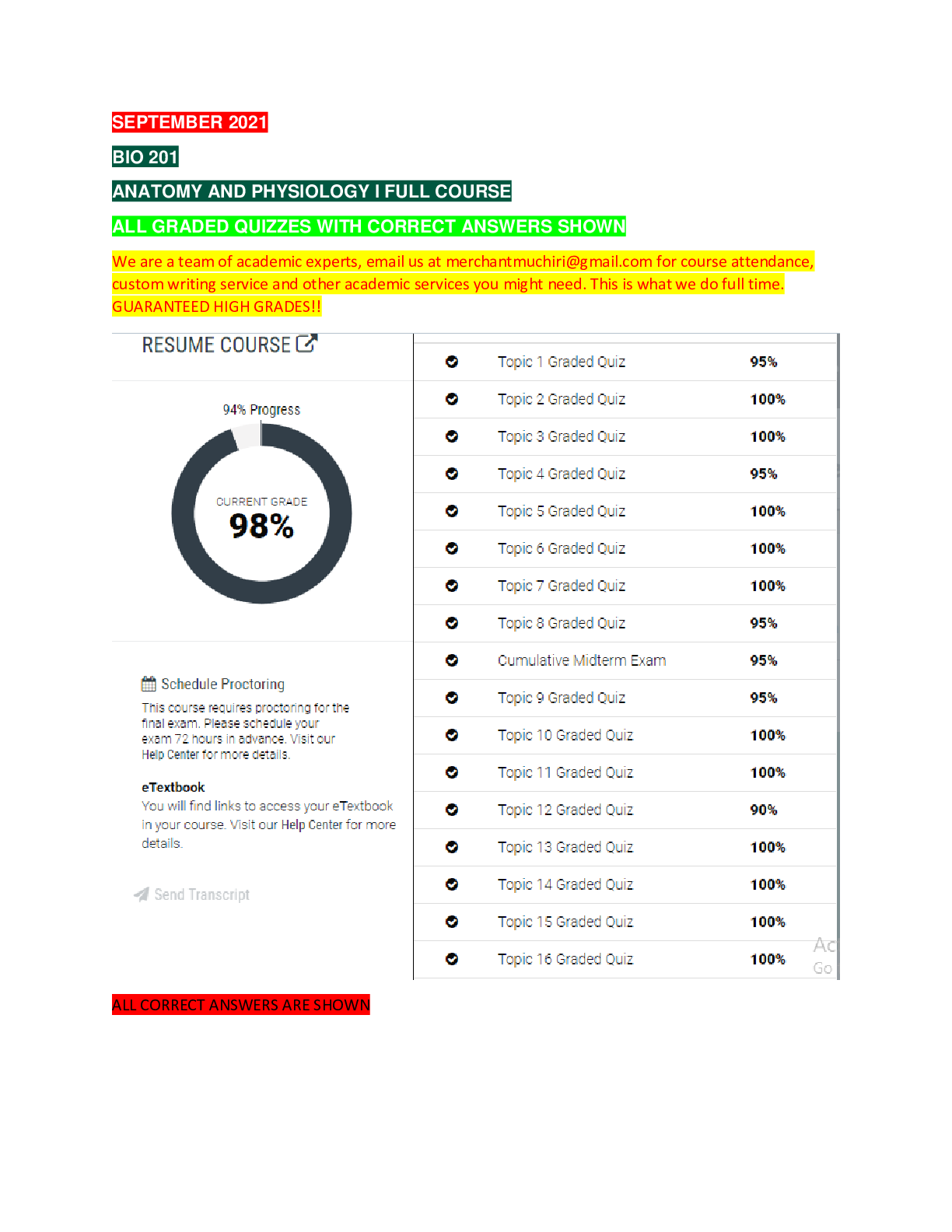
Buy this document to get the full access instantly
Instant Download Access after purchase
Add to cartInstant download
We Accept:

Reviews( 0 )
$35.00
Document information
Connected school, study & course
About the document
Uploaded On
Sep 10, 2021
Number of pages
215
Written in
Additional information
This document has been written for:
Uploaded
Sep 10, 2021
Downloads
0
Views
69


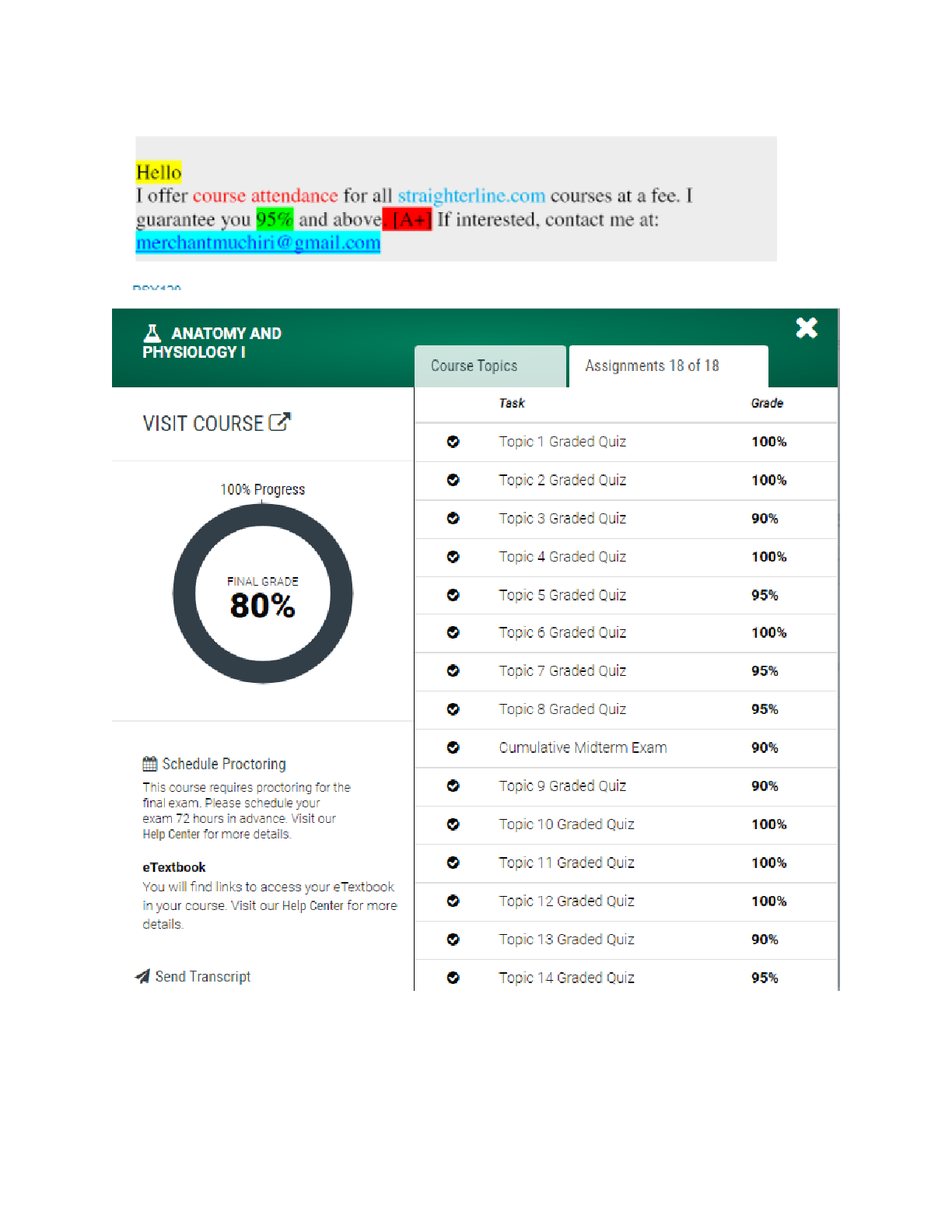
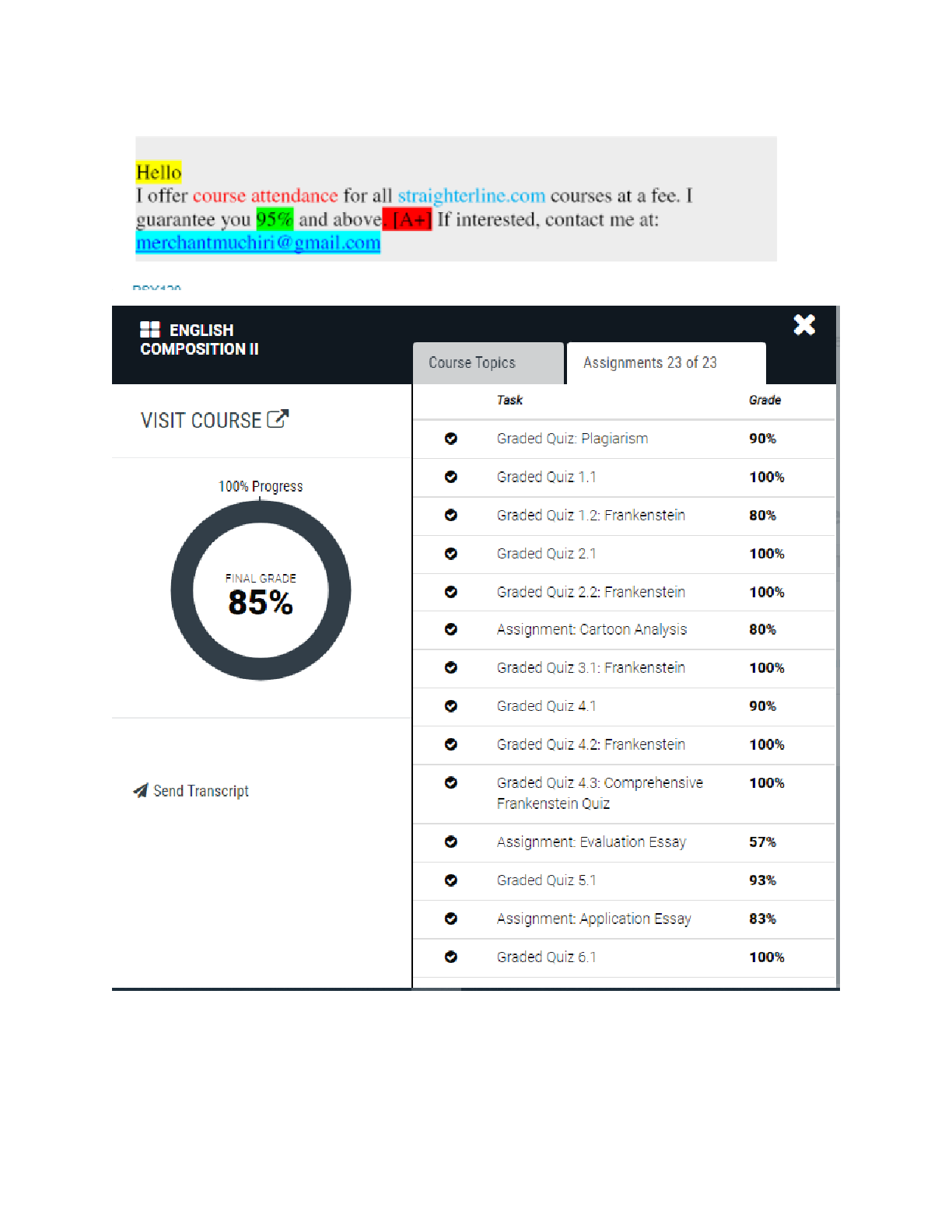
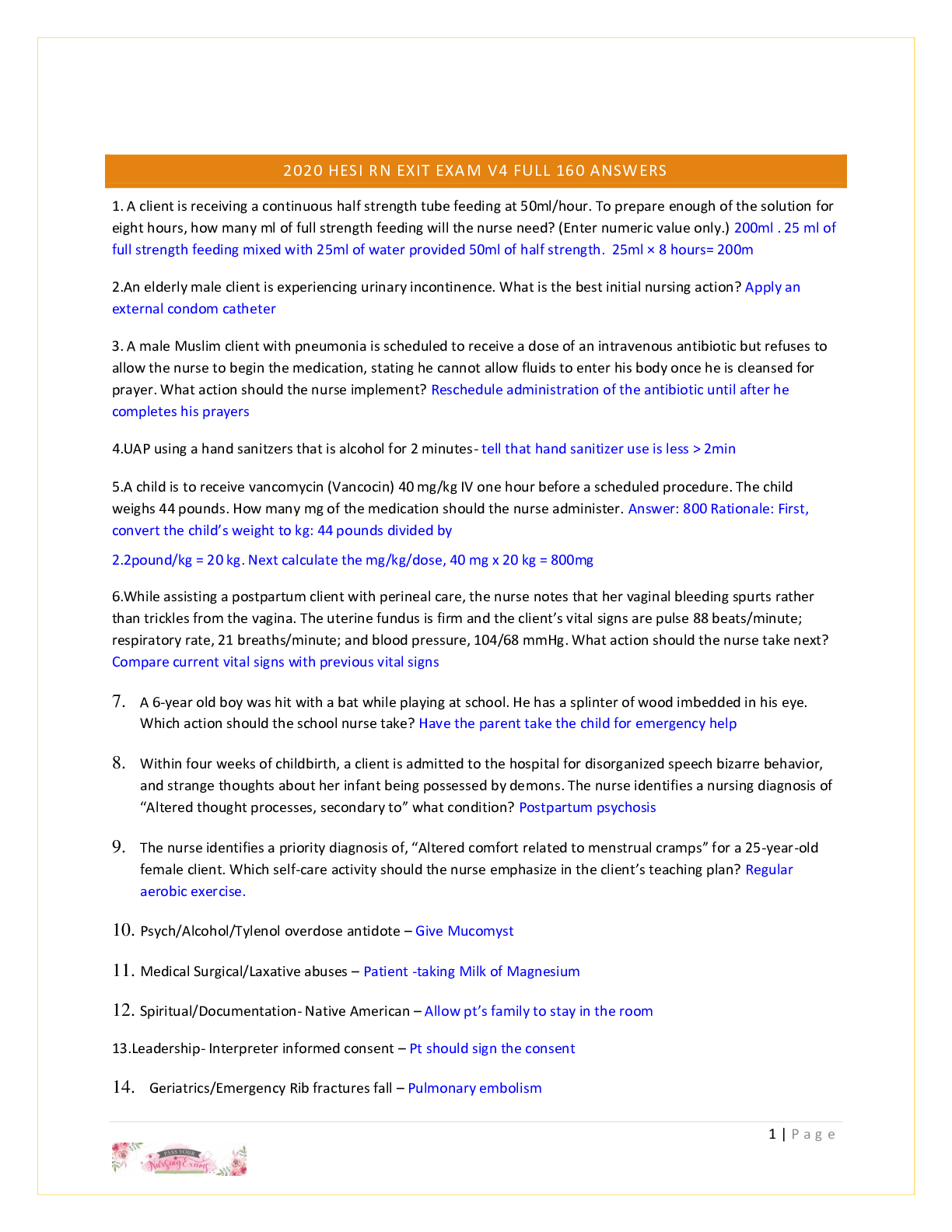

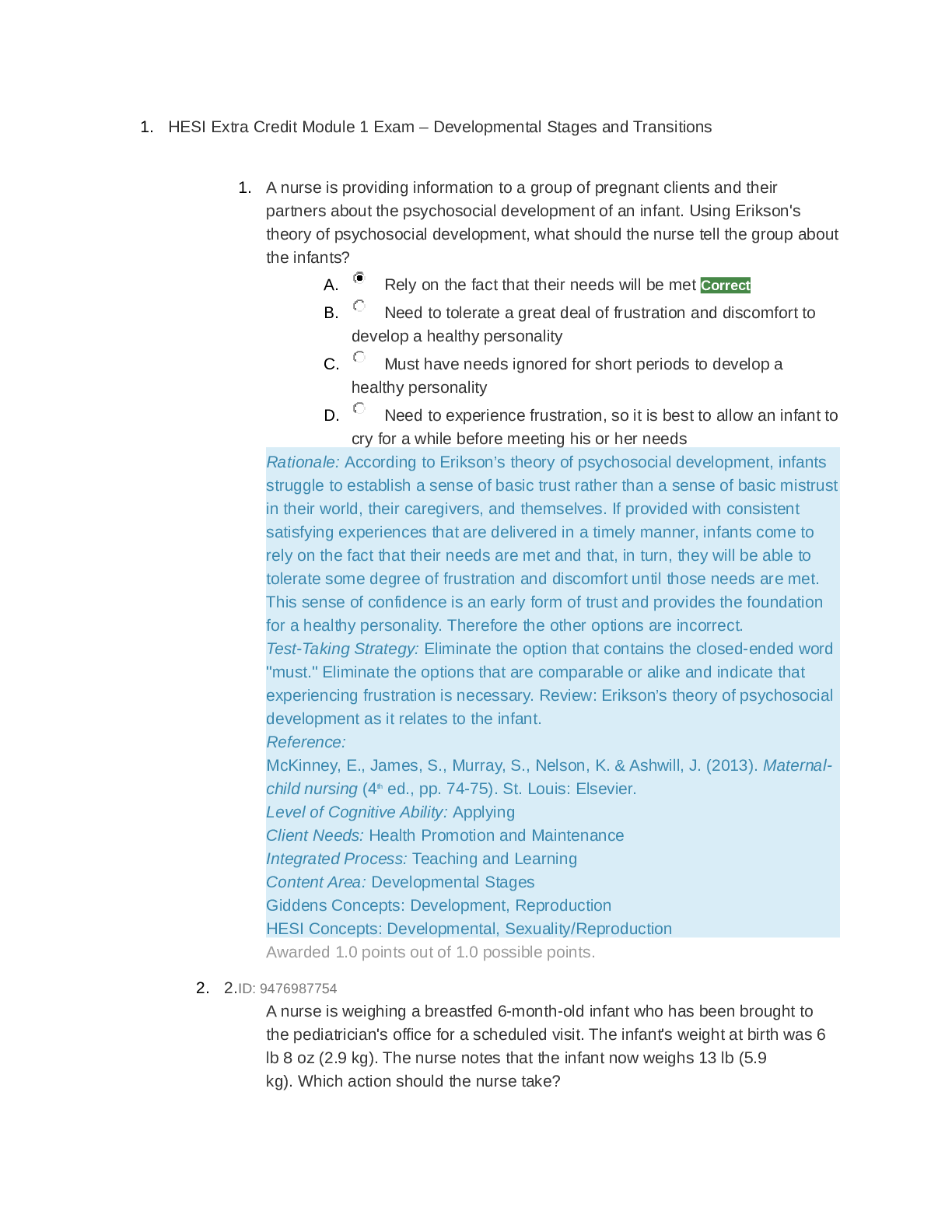

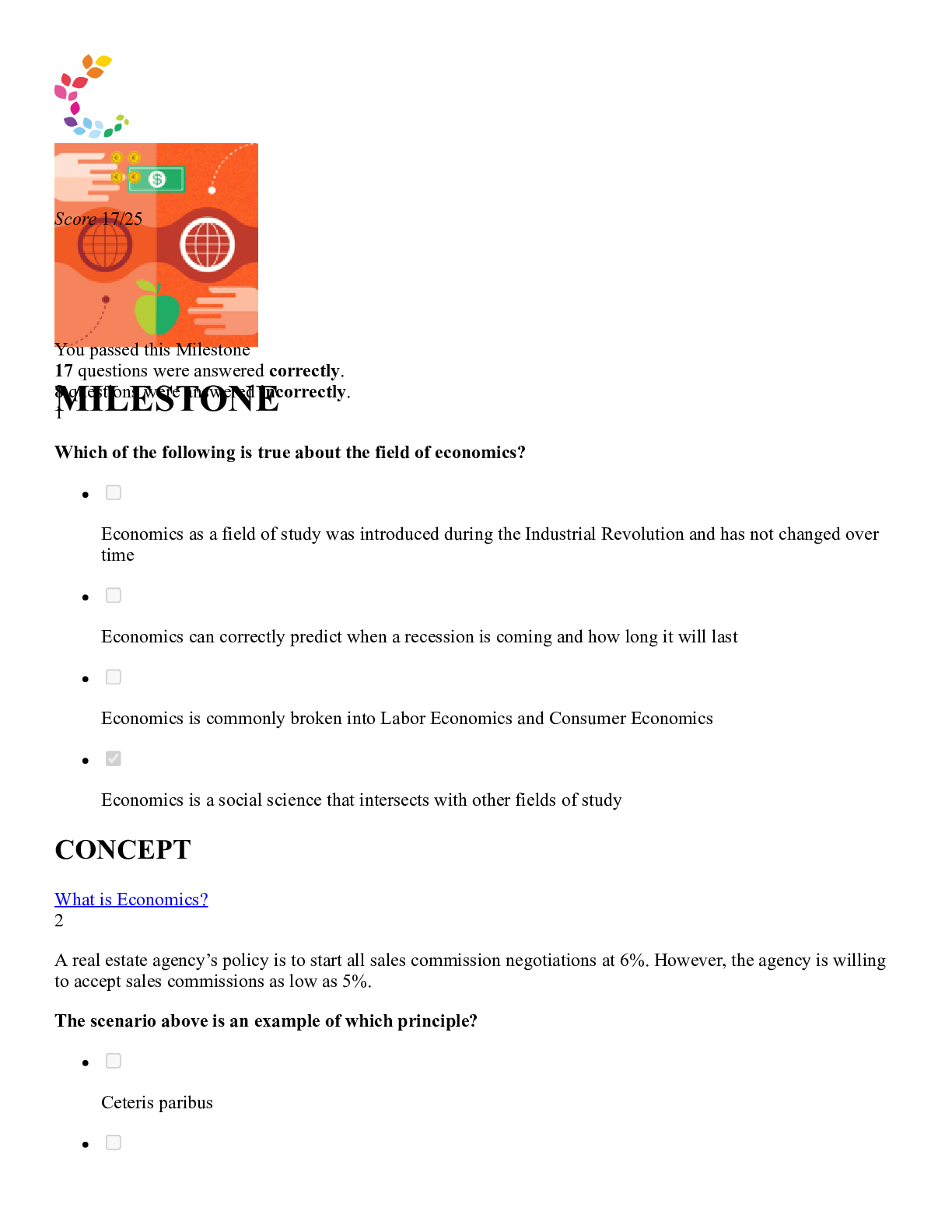
.png)
.png)
.png)


